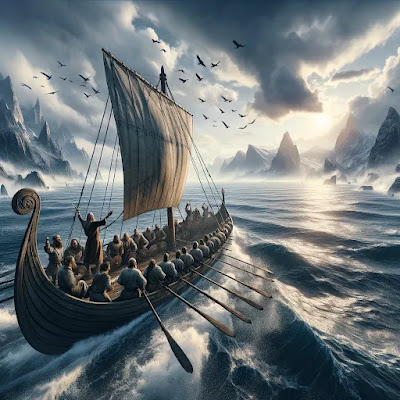Viking Raids and Warfare: A Glimpse into the Fierce Norse Warriors
Viking Raids and Warfare: A Glimpse into the Fierce Norse Warriors
The Viking Age lasted for about three centuries from the late 8th to the early 11th century. It was characterized by the expansion of Norse warriors’ raids and wars. Vikings came from Denmark, Norway, and Sweden in Europe. They went on many expeditions in Europe, the North Atlantic region and even down to Mediterranean Sea. This article explains Vikings’ strategies, motivations and impacts of their raiding and warfare to show why Norse warriors were so terrible.
The Beginning of Viking Raids
The Masters of the Sea
Viking raids had been facilitated by mastery skills in shipbuilding. A Viking longship was amazing with its shallow draught,symmetrical bow as well as stern and big sail.It was fast in speed, flexible enough for use both on high seas as well as slim river courses therefore enabling Vikings to mount surprise attacks.
Warfare Tactics and Weaponry
Viking warfare tactics were flexible and adaptable, often depending on the circumstances of each individual battle. While Vikings are known for their warriors’ deadly close combat skills, they also engaged in psychological warfare where fear served as a weapon against their enemies. Weapons at their disposal consisted of swords, axes, spears and bows, with the war axe becoming a sort of symbol of Viking warrior society.
The Motivations Behind the Raids
There were several motivations behind Viking raids. Among them was economic gain that became one of the major factors because wealth that was plundered would enhance social position and improve economy back home. However, overpopulation and limited agricultural land also drove Vikings to seek new territories. Furthermore, their political structures influenced these raids since successful chieftains or kings could use them to enhance their prestige in society.
The Transition from Raiding to Settlement
Gradually viking ships went from being raiding vessels to those aimed at systematic colonization and settlement mostly in Britain’s Isles, Normandy plus some parts within Russia Empire coupled with Byzantine ones. In places like Dublin, York as well as Novgorod we can see how Vikings turned into rulers from raiders by developing trade networks while integrating into local cultures but still maintaining their distinctiveness.
Impact of Viking Raids and Warfare
The significance of Viking raids in Europe was significant, which altered military engineering with fortification construction as well as European kingdoms developed them to help secure against these incursions. Besides, their exploratory missions such as voyaging to North America illustrate how they shaped the medieval world not just through conquest but also exploration and cultural exchange.
Norse Warriors’ Legacy
The remains of Viking sea raiding and fighting show how skilful Norsemen were at navigation, war strategy and tactics. Though historical sources usually depict Vikings as little more than savages, modern researches and archeological excavations reveal that they had a sophisticated system of governance anchored on trade and diplomacy.
These stories of the Viking marauders are woven into the fabric of norse sagas; they form part of mythology acting as symbols for indomitable spirit and adventurous ethos that characterized the viking age. As we get to know more about their history, we unravel a complex tapestry portraying a people adept in warfare at the same time skilled in diplomacy, commerce, rule-making thereby leaving an enduring mark on medieval society.
By understanding the Viking Age’s broader dynamics, we will be able to know more about the Viking raids and warfare which were characterized by movement, conflict and cultural encounters. The Vikings were not just destroyers but also had a say in shaping the course of European history through their raids, wars and eventual settlements.
This analysis of Viking raids and warfare provides an opportunity for us to understand what life was like among the Norsemen as well as appreciate how these fierce warriors influenced history. The stories as told about their attacks and combats are still used to generate fascination and respect for one of the most celebrated warrior societies in history.








